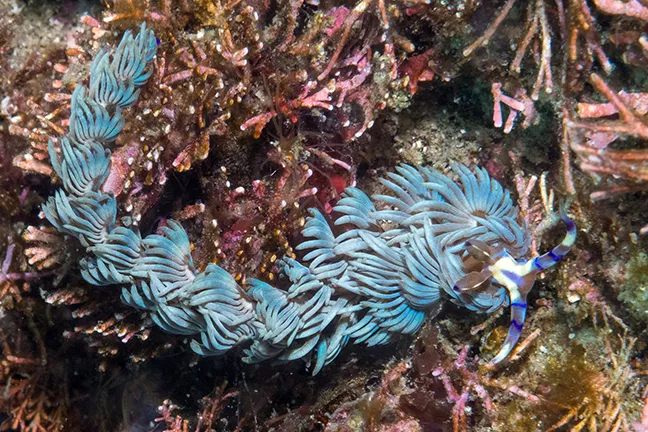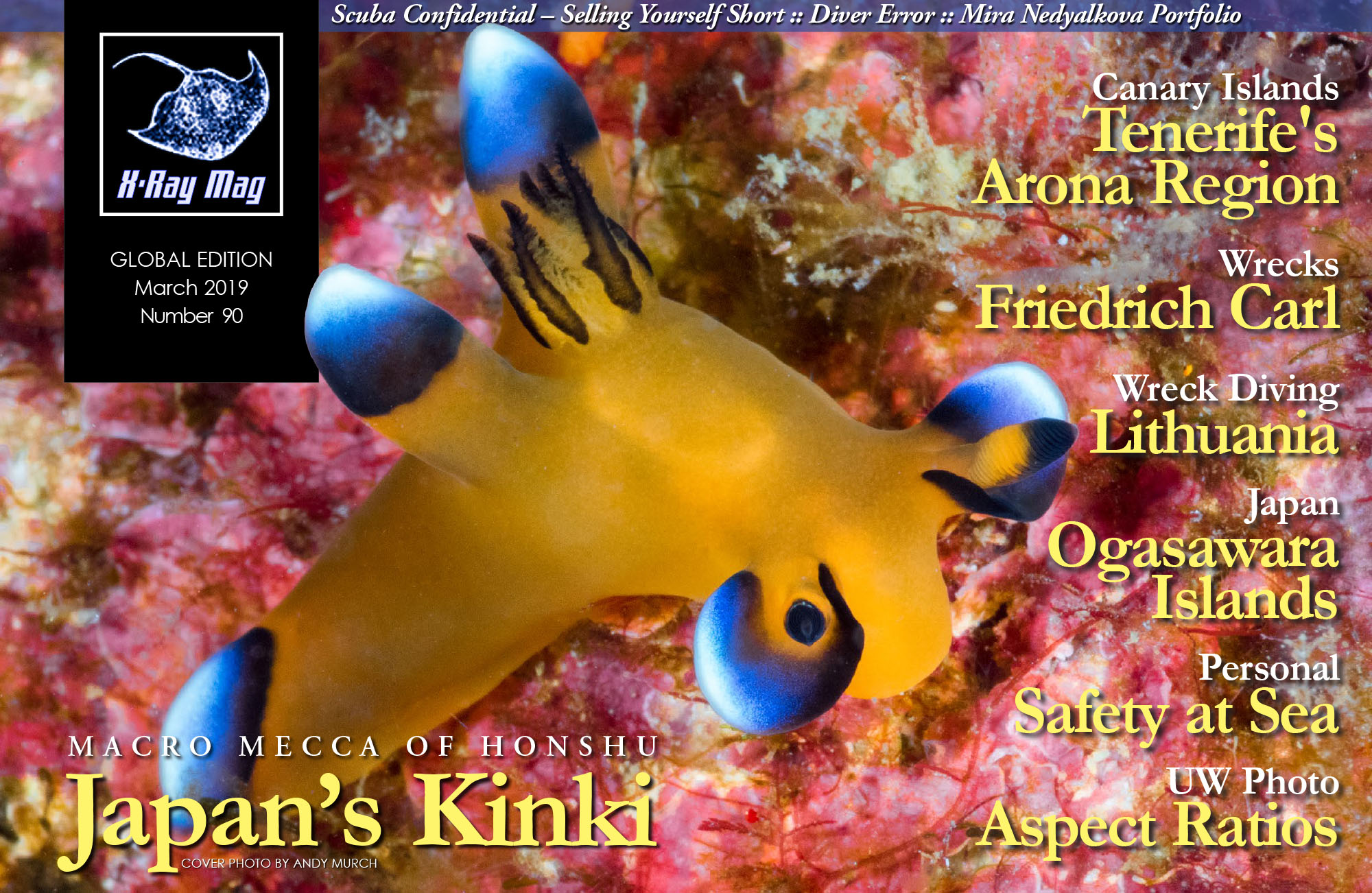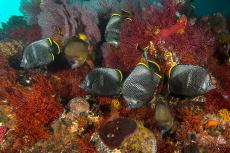Kinki is a ruggedly beautiful peninsula in the southwest of Honshu, Japan. The area is best known for the Shinto shrines of Kumano, which sit atop forested mountains in the center of the region. Each year, thousands of tourists and devotees undertake a pilgrimage through the mountains to reach the tranquil sanctuary, which is said to be a place of physical healing. Japanese divers also flock to Kinki to enjoy the region’s fabulous abundance of endemic marine life.
Contributed by
Factfile
40 COMMON NUDIBRANCHS FROM KINKI:
Herman’s Bornella
— Bornella hermanni
Ornate Cadlinella
— Cadlinella ornatissima
White-edged Ceratosoma
— Ceratosoma sp.
Many-lobed Ceratosoma
— Ceratosoma tenue
Three lobed t-bar nudibranch
— Ceratosoma trilobatum
Collingwood’s Chromodoris
— Chromodoris collingwoodi
Geometric Chromodoris
— Chromodoris geometrica
Yellow-edged Dendrodoris
— Dendrodoris arborescens
Denison’s Dendrodoris
— Dendrodoris denisoni
Dark Margin Doriprismatica
— Doriprismatica atromarginata
Ornate sap-sucking slug
— Elysia ornata
Flabellina sp.2
— Flabellina sp.2
Alder’s Doris
— Goniobranchus alderi
Gold and purple Goniobranchus
— Goniobranchus aureopurpureus
Oriental Goniobranchus
— Goniobranchus orientalis
Goniobranchus sp.
— Goniobranchus sp.
Brown-lined paper bubble
— Hydatina physis
Robe hem Hypselodoris
— Hypselodoris apolegma
Japanese Chromodoris
— Hypselodoris festiva
Spotted Hypselodoris
— Hypselodoris maculosa
Triton’s Hypselodoris
— Hypesodoris tritoni
White’s Hypselodoris
— Hypselodoris whitei
Purple-tipped Janolus
— Janolus toyamensis
Jorunna sp.
— Jorunna sp.
Ornate Kalinga
— Kalinga ornata
Magnificent Miamira
— Miamira magnifica
Hiroi’s Okenia
— Okenia hiroi
Japanese Okenia
— Okenia japonica
Painted Phyllidia
— Phyllidia picta
Protaeolidiella atra
— Protaeolidiella atra
Blue dragon nudibranch
— Pteraeolidia cf semperi
Ornate batwing slug
— Sagaminopteron ornatum
Cherry blossom nudibranch
— Sakuraeolis sakuracea
Kava’s Tambja
— Tambja kava
Gloomy nudibranch
— Tambja morosa
Variable Tenellia
— Tenellia diversicolor
Pikachu nudibranch
— Thecacera pacifica
Black-spotted Theracera
— Thecacera sp.1
Splendid sap-sucking slug
— Thuridilla splendens
Purple sap-sucking slug
— Thuridilla vataae
DIVE OPERATORS
There are lots of dive shops along the coast of Kinki. These are the ones we dove with. Some speak a little English but the easiest way to arrange your dives is to use Japan Diving Experience, which (for a small fee) can arrange all of your diving and accommodation before arrival and be available by phone in case you have any communication problems while on the ground.
BOOKING ASSISTANCE
Japan Diving Experience
japan-diving-experience.com
TANABE AREA
Tanabe Diving Service
tanabedivingservice.jp
SHIRAHAMA AREA
Shirahama El-mar
el-mar.net
KUSHIMOTO AREA
Bubble Ring Divers
bubble-ring-divers.com
OWASE AREA
Sea Dream OWASE
owase-seadream.com
SHIMA AREA
Aristo Divers
aristodivers.com
Kinki’s southernmost dive spots are draped in lush soft corals, reminiscent of the tropical reefscapes of Southeast Asia, but Kinki is only “tropical” for half of the year. During the winter months, cold water creeps southward from the eastern coast of Russia, lowering ocean temperatures from a toasty 26°C to a rather chilly 10°C. Unperturbed, local divers switch from thin neoprene suits to thick drysuits and continue to enjoy the region’s underwater beauty throughout the year.
Winter is a particularly good season to look for Kinki’s amazing diversity of nudibranchs, which the peninsula is famous for. Specific species differ from one town to the next, so the best way to experience as many nudibranchs as possible is to rent a car and drive around the coast, stopping for a day or two in each location. The locals are extremely passionate about diving so there is no shortage of dive shops, and the dive guides (some of whom speak English) are experts at spotting tiny critters that visiting divers would likely miss.
Intrigued by the prospect of ticking off numerous new species on a single trip, my wife and I made the necessary arrangements and flew to Shirahama, which offers easy access to some of the best diving in the region.
Tanabe
Our first stop was Tanabe, a quaint little town known among Honshu divers for its deep-water neon-yellow anemones, and of course its abundant sea slugs. In other areas, the anemones only occur below 150m, but in Tanabe, you can encounter them within recreational diving limits. To protect the fragile anemones from habitat destruction, the Japanese government has listed them as a national monument.
After a bounce dive to see the anemones for ourselves, we worked our way up the reef slope, ticking off nudibranchs every few meters. The most common nudis in Tanabe (and in all of Kinki) are 2cm long Japanese Chromodorises (Hypselodoris festiva), an endemic species that is so prolific that local “branchers” don’t pay them a second thought. But as a first time visitor to the region, I could not help pausing now and then to admire their royal blue mantles, edged in lemon yellow and topped by rusty orange gills and rhinophores.
Another species that we bumped into, both here and later in the trip, was a many-lobed Ceratosoma (Ceratosoma tenue), a whopper of a nudibranch that reaches 12cm long and ranges all the way from Japan to tropical Africa. This variably-colored species can be identified by the wide lobes on its mantle and a poisonous, chemical-filled horn positioned just behind its gills, which it uses as a defensive weapon to scare off any potential predators foolish enough to give it a nibble.
In Tanabe, we also ran into a spectacularly colorful nudibranch—the lovely Miamira magnifica. This flamboyant animal is highly variable in color, but the one we found lived up to its name—magnificent!
On our second day, the wind picked up, but we were still able to do shore dives in one of Tanabe’s protected bays. After adding several more nudibanchs to the trip list, I went looking for clouded salamanders in a muddy pond close to the dive site. Underwater shots were impossible in the murky water, but we managed to get some nice portraits on the bank. Clouded salamanders are endemic to Japan, and the ones in Kinki are particularly noteworthy because they live so close to the ocean that they have evolved to become somewhat tolerant of saltwater. Perhaps one day, this meek little animal will be the ancestor of the first marine amphibians!
Shirahama
Before following the coast westwards, we zipped back to Shirahama for a day of diving. First up, we dropped in on one of Kinki’s few accessible wrecks—a small tugboat crawling with more nudibranchs, including Theracera pacifica, a cute little slug that the locals call “Pikachu” because of its resemblance to the Pokemon character of the same name. The wreck was also home to a handful of beautiful dragon morays that were more than happy to pose for the camera.
Between dives in Shirahama, we ran into a friendly researcher who was carrying a jar containing a large, rarely seen, deep-water nudibranch. The captive mollusc was destined for a local university for study. After an animated conversation in Japanese with our divemaster, the researcher smiled and handed over the jar, which we took with us on the following dive. When we reached the sea floor, our divemaster released it so that we could get a few shots of a species that would otherwise be impossible to see. The blobby-looking nudibranch was a sand-dweller, which immediately tried to dig its way to freedom, but the luckless mollusc was soon recaptured and returned to its owner as intended.
The concept of a canned nudibranch shoot was rather comical but what impressed me about the experience was how willing everyone was to go out of their way for us. Everywhere we went, we were treated like royalty. This rang true at every dive shop, every hotel and every restaurant that we visited. Apparently, Japanese hospitality knows no bounds!
Kushimoto
Our next stop was at a small fishing village on the southern coast of Kinki called Kushimoto. Here, the reef was relatively rocky, but the dive sites were packed with schooling fish, which I would have loved to photograph if only I had enough time to squeeze in a wide-angle dive or two. Not surprisingly, the macro life was also excellent. Noteworthy nudibranchs included Okenia japonica and Okenia hiroi—both endemic to Japan and each smaller than a grain of sushi rice.
Kushimoto turned out to be an excellent place to photograph frogfishes. We stumbled upon at least three species on a single dive, but my favorite was a miniscule, orange and white clown frogfish about the size of a pea.
Kushimoto also delivered numerous crinoid squat lobsters that one would normally expect to see in the tropics. I guess that in the summer, they would not seem so out of place, but it is a strange feeling shooting tropical species while wearing a drysuit, hood and bulky neoprene gloves.
Owase
By our fifth day, my tired eyes needed a rest from the wonderful world of Japanese super-macro life, so we headed to a renowned wide-angle dive site near a town called Owase.
On the way, we stopped at Hashigui-iwa Rocks where the coastline has eroded into a series of dramatic spires said to resemble bridge pillars. Legend has it that a Buddhist teacher named Kobodaishi created the spires in a single night in order to win a bet with a fallen angel.
The dive site at Owase is actually an artificial reef made of metal beams that are dripping with hard and soft corals of every shape and color. None of the locals remember exactly how long ago the reef was created but they estimate it was erected in the late 1960s. The sheer biomass of growth on the man-made reef has rendered the underlying structure completely unrecognizable—a shining example of the ocean’s ability to flourish with some help from forward-thinking humans.
Large groupers and spiny-looking John Dories swam confidently in and out of the open spaces as if they owned the place, which of course they did. I have always wanted to photograph some John Dories, so these extremely tame ones were a nice addition to an already impressive dive spot.
Shima
After Owase, we had just enough time to squeeze in one more dive destination. For the sake of diversity, we headed to Shima in the extreme northeast of Kinki where corals give way to gently swaying kelp beds. Many of the fishes and invertebrates at Shima are close cousins of species that occur in Western Canada and Alaska, but with a subtly different Japanese flair.
We picked Shima in particular, because we had heard that it is a great place to photograph Japanese lumpfish, and we were not disappointed. Lumpfish (or lump-suckers, as they are sometimes called) are tiny balls of cuteness. Their fins are so small in comparison to their bodies that they are terrible swimmers, but their modified pectoral fins form a suction cup that helps them stick to rocks or kelp fronds when the surge tries to push them around.
Lumpfish come in many colors depending on their environment. We saw a number of different flavors, but the prettiest ones were a deep pink that stood out against the kelpy background.
Like elsewhere, there was no shortage of gorgeous little sea slugs. Many were species one can see throughout the Indo-Pacific, but there were a few rarities too.
I spent my final minutes trying to photograph a blue dragon nudibranch (Pteraeolidia cf semperi). It was challenging shooting macro nudibranchs in the surge, but I eventually nailed some relatively sharp pictures and retired to the dive boat for the short ride back to land.
Afterthoughts
After a final tally, we had photographed 48 different sea slugs in 12 dives and seen countless more, which were either too miniscule or too awkwardly positioned to photograph, plus a great selection of endemic fishes and crustaceans. For macro fans, Kinki clearly deserves to be on the international diver’s bucket list, especially for nudibranch geeks like us! ■



























































